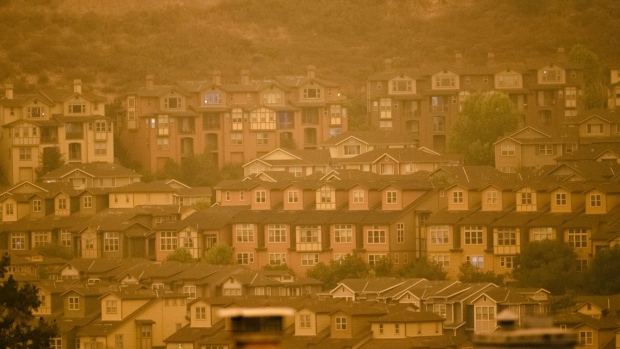Sep 11, 2020
When Wildfire Smoke Blotted Out the Sun, Rooftop Solar Withered
, Bloomberg News

(Bloomberg) -- When deadly wildfires tinted Western skies a Martian hue this week, homeowners with their own rooftop solar systems were able to tell with great precision just how much useful sunlight reached them through the gloom: next to none.
Wednesday was “the worst generation day, ever,” said Mary Holstege, a retired software engineer in Cupertino, California, who went solar a year ago. Her system, which puts out 40 kilowatt-hours a day in the summer, barely dribbled out 1.65 — maybe enough to dry a load of laundry.
Others fared worse. Bentham Paulos, an energy policy consultant in Berkeley, called the solar power system he’s had for 10 years “extremely predictable every single day, except this week.” On Wednesday he peaked at about 12 watts, or enough to light one LED bulb, “and it went away,” he said.
The solar blackouts highlight a cruel irony of life amid California’s climate crisis: Over the last few years, homeowners began investing in rooftop systems and batteries to hedge against intentional power outages aimed at preventing wildfires. But now some blazes have become so large, they’re effectively shutting down the solar.
A worst-case wildfire scenario could reduce annual solar-energy production from affected installations by as much as 2%, according to Dan Whitten, spokesman for the Solar Energy Industries Association. “We take any lapse in solar performance very seriously,” he said, “but the longer term and more serious implications of this environmental devastation are much more alarming and need to be addressed, in part by stronger clean-energy policies.”
It’s not the first time a wildfire-stricken region has seen solar power misbehave, and far from the last. During the Australian bushfires that began last year, months of intense smoke resulted in decreased and harder-to-predict generation from the country's rooftop-solar fleet, said Will Edmonds, a Sydney-based analyst at BloombergNEF. But this had little impact on customers losing power. Most can still draw needed electricity from the grid.
"In fact, several rapidly deployable solar and storage systems were used to restore power to critical infrastructure in some of the worst-affected regions,” Edmonds said in an email.
So far, there’s no sign that smoky skies will erode interest in residential power — and in fact, the fires and recent utility blackouts may be creating more demand. SunPower Corp. on Wednesday generated more appointments with potential new customers than all but two other days in a three-year-old sales initiative.
“We see more people saying, ‘We need to do something,’” Chief Executive Officer Tom Werner said in an interview. “The bigger root cause they’re worried about is the fires themselves and their impact on their power supply."
Solar companies have boasted that residential systems, coupled with battery storage, can make homes more resilient amid storms and power shutoffs. What happened this week “doesn't necessarily undermine the case for solar-plus-storage as a form of backup," Logan Goldie-Scot, a San Francisco-based BNEF analyst, said in an email. "A climate-resilient system would also have multiple layers to ensure that the power stays on."
In California, the size and extent of utility-scale solar operations cushioned hits to the overall system, with the loss of production in northern parts of the state offset by slightly clearer skies in the south. Still, solar production across the state clocked in at 9 gigawatts at noon on Wednesday, lower than on that date last year, according to data from the grid operator.
Scientists understand that climate change is making wildfires worse. The amount of land burned in the Western U.S. has doubled over the last generation, and fire season is two months longer than it used to be. Extreme temperatures—global warming’s calling card—dry out vegetation, which is exactly what happened before lightning-ignited fires last month.
In addition to investing in solar, some, like Paulos, are seeking clean-energy policies that address the root problem. A member of the Berkeley Energy Commission, he pushed for the city to stand up a ballot measure in November that would establish a dedicated fund for its climate action plan, inspired by similar initiatives in Boulder, Colorado, and Portland, Oregon. This week, he said, made the need for such funding obvious to all.
“I’m looking at the sky this week and the air, and thinking we don’t need to advertise for this ballot measure,” he said. “We just need to tell people to look out the window.”
©2020 Bloomberg L.P.


